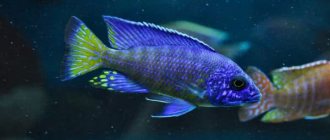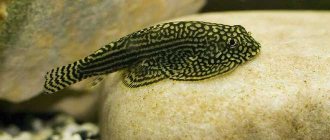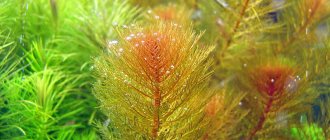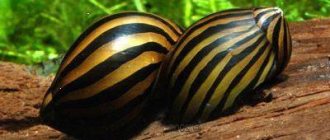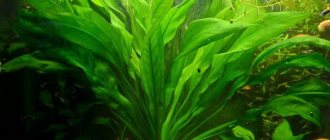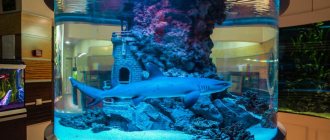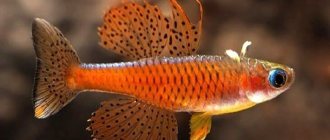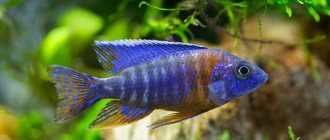10.27.2019Pisces0
Chain catfish are popular among aquarists. Their unusual colors and peculiar behavior attract breeders. Only one species was left without due attention. Loricaria has unusual external characteristics. In addition, they are unpretentious, non-aggressive, and easy to adapt. This species is omnivorous, does not touch vegetation and fry of viviparous fish. Watching them is a pleasure.
- 1 Description and natural habitat
- 2 Mr. Tail recommends: variety of species
- 3 Basics of aquarium keeping
- 4 Compatibility
- 5 Feeding
- 6 Breeding
Description and natural habitat
The homeland of these catfish is in the northwestern part of South America in the Magdalena River. Depending on the species, and there are about 30 of them, the fish grow up to 25 cm. In nature, they choose sandy areas of the bottom with a cover of fallen leaves. Against such a background they are hardly noticeable.
Externally, Loricaria looks like a miniature water dragon. The wide head turns into a uniformly tapering body, which becomes very narrow closer to the caudal fin. There are spikes on the upper part, which gives the catfish a menacing appearance. The colors are varied, there are brown, gray-black, spotted varieties. The back is protected by bone plates, the abdomen is almost flat and light. The dorsal fin is high and narrow. The mouth sucker is located on the bottom of the head.
The behavior of the fish is similar to the habits of ancistrus; moving along the bottom of a reservoir is more like crawling than swimming. It is most active during the twilight hours of the night.
Omnivorous pet, lives in flocks. Males are distinguished by the presence of brushes on their pectoral fins. Sexual maturity is reached at the age of 1 year.
Photo gallery of Loricaria:
Loricaria (Dasyloricaria filamentosa)
Loricaria, or filamentous loricaria, or filamentous loricaria (Whiptail) is a popular aquarium catfish with an unusual appearance. In the wild, it lives in very clean mountain rivers and streams. Most active at dusk. It is a little shy, so a variety of hiding places are needed in the aquarium. Perfectly cleans the aquarium of algae fouling. Gets along well with other peaceful fish species. Willingly accepts live and plant food. It reproduces without problems in aquariums.
Habitat: South America - Colombia (Magdalena River basin). Habitat: turbulent mountain rivers and streams. Description: the body is greatly elongated, the body narrows and gradually turns into the caudal peduncle. The anterior part of the body is flattened. On the sides there is a row of bony plates that protrude from the caudal peduncle. The dorsal fin is relatively high. The mouth is in the form of a suction cup, with which the loricaria scrapes off algal fouling from various surfaces. The upper ray of the caudal fin has a thread-like continuation. Color: the main background of the body is from sand to brownish-yellow, with numerous dark brown dots and strokes, which merge into transverse stripes on the tail. The fins are transparent with dark spots. Size: in nature, loricaria grows up to 25 cm, in aquariums - up to 15 cm. Life expectancy: up to 10-15 years. Article on the topic Arnold's Otocinclus (Otocinclus arnoldi)
Aquarium: general aquarium, oblong in shape. Dimensions: for one adult fish, a volume of 80 liters and at least 50 cm in length is required. Water: pH 6.5-7.5, dH 6-15°, active aeration, powerful filtration. Weekly changes of up to 20-30% water. Loricaria loves oxygen-rich, flowing, clean water. Temperature: 22-26°C. Lighting: diffuse, dim. Soil: coarse river sand. Plants: dense thickets of large-leaved plants that darken the bottom of the aquarium. Decoration: natural driftwood and roots, caves, grottoes, PVC pipes (20 cm long and at least 3-6 mm in diameter) and other decor.
Feeding: willingly accepts live, plant and combined food. Food is given in the evening.
Behavior: Loricaria leads a crepuscular and secretive lifestyle. Can be kept in small groups. Fish do not swim, but crawl from place to place. To defend itself, it uses its tail. Personality: peaceful. Young people are quite shy, so they are active mainly in the dark. Water zone: bottom layer of water. Can be kept with: peaceful fish (discus, tetra, apistogramma, corydoras, etc.). Cannot be kept with: aggressive, large fish.
Fish breeding: pair spawning, seasonal (January-June). Loricaria spawns both in a general aquarium and in a separate spawning tank. Frequent water changes (up to 50%) and increasing its temperature by 2-3°C stimulate spawning. Producers are fed abundantly with plant foods. Spawning aquarium with a volume of 30 liters or more, a ceramic or plastic tube is used as a substrate (diameter 2-3 cm, length 15-20 cm), water level 15-20 cm, aeration is required. Water parameters: T 24-28°C, dH up to 10°, pH 6.5-7. The male cleans the tube he is busy with, and the female sweeps out and glues eggs into it. After spawning, the male takes care of the offspring. After spawning, the water level is reduced to 10-15 cm. Sexual differences: the male is slimmer than the female, there are “whiskers” on the pectoral fins and head. Puberty: occurs at the age of 8-12 months. Quantity of eggs: up to 150-300 yellowish eggs with a diameter of 2 mm.
Article on the topic Mystus tengara Incubation period: 7-11 days. Offspring: fry swim for 2 days. As soon as the fry begin to feed on their own, they are transferred to a nursery aquarium in which a filter with activated carbon is installed, aeration is running, there is a weak current, the water level is up to 10 cm. Juvenile loricaria are sensitive to “dirty” water, so daily water changes of up to 10% are required to fresh ones of the same composition and temperature. Growth rate: fast. Feeding of fry: starter food - “live dust”, rotifers, microworms, crushed lettuce leaves, a little later - brine shrimp. Removal from parents: after spawning, the female is removed; the male is removed when the fry begin to spread around the aquarium in search of food. Comments: loricaria can climb into the filter tubes. Pinkish, brown and black forms are available on sale.
Mr. Tail recommends: variety of species
Of the known varieties of Loricaria, only a few have taken root in the aquarium:
- Common - the most popular, well known among fish lovers. Adults reach 15 cm in length. Painted in various shades of sand, beige and brown. The body is covered with dark spots, which gather into clearly visible stripes closer to the tail. The pet spends its days in a shelter or cleaning the walls of the tank.
- Red - bred artificially and is distinguished by even greater grace, compared to other varieties. Lives in the lower layers, like all bottom species. During the day it hides in caves, grottoes or under algae leaves. It reaches a length of 12 cm. It got its name because of its color, which ranges from bright orange to dark red. In this type of Loricaria, the males are smaller and slimmer.
- Peruvian - the color of the back is sandy brown, the sides are dark, brownish-olive tones, covered with yellow spots. The behavior does not differ from the standard one. Males have small spines on their cheeks.
- Parva is a funny catfish with a rounded nose. Colors range from tan to gray. Randomly located small spots are scattered throughout the body, sometimes forming noticeable stripes. Parva's fins are transparent with dark spots. Males have bristles on the lower part of their snout.
Loricaria
The loricaria fish belongs to the catfish family and lives in the warm waters of South and Central America. Thanks to its catchy and unusual appearance, it can decorate any aquarium, and neither children nor adults will get tired of watching its behavior for a long time.
general characteristics
Like all catfish, these exotics prefer to stay in the bottom part.
Under natural conditions, they reach a significant size of 25 cm, but in a home aquarium you can grow an individual with a maximum length of 18 cm.
Males are significantly smaller than females and have characteristic brushes on their pectoral fins. With age, characteristic growths appear on the head of catfish, reminiscent of tree bark, which makes them invisible against the background of the bottom.
The chain catfish loricaria is a unique fish because it brings tangible benefits to the entire aquarium.
Under natural conditions, these fish live in fast-flowing rivers, and their suckers help them securely anchor themselves to the bottom. Catfish eat the remains of dead animals and algae, helping to maintain the ecological balance of the reservoir.
Loricaria: types
There are several dozen species of these exotics, but not all are suitable for home breeding. They differ not only in appearance, but also in their habits and eating preferences, which allows you to choose the ideal inhabitant for specific conditions. The most common in our country are:
- Loricaria Similima is a fish from South America, widespread in Venezuela and Argentina. Its name is translated into Russian as “royal”; it was given to the fish for its luxurious branched mustache and sedate manner of movement. The light color harmonizes well with dark wide stripes, which become darker when maintained correctly. The water temperature for them ranges from 22° C to 30° C, the optimal acidity is not higher than 7-8 pH;
- Loricaria vulgaris is easy to breed and has a wide variety of colors: sand, beige and pinkish shades are present. The body is heterogeneous in thickness and noticeably tapers towards the tail. In the front part of the body the color is variegated, consisting of dots and chaotic strokes; towards the tail they merge into wide stripes. Males have bristly processes along the edges of their heads. Recommended temperature – 23-28 °C, acidity – 6.5-7.5 pH;
- Peruvian Loricaria - (Latin name of the fish Lanceolata) - grows up to 13 cm in length and is distinguished by a beautiful light brown color with dark diagonal stripes. Like other species, it prefers to stay in flocks. Optimal maintenance conditions: temperature – 22 -28°C, acidity – 6-8 pH. There is also another variety - Loricaria Red, distinguished by its specific bright color.
General conditions of detention
The fish are not demanding on conditions and are perfect for beginners. Choose a spacious aquarium of 100 liters or more, since these chain-mail catfish are schooling fish and should have sufficient space for swimming.
Loricarias, which are predominantly nocturnal, do not tolerate bright lighting. Install diffused light, and plant plants with spreading wide leaves at the bottom and place several driftwood so that exotic plants can hide there.
Small pebbles are suitable as soil, and when containing red loricaria, well-washed river sand is also suitable. You can add a layer of dry leaves and bark.
Be sure to take care of filtration: while digging at the bottom, catfish will definitely pick up turbidity and small fractions from it.
When keeping catfish in an aquarium, loricaria have the following requirements for water:
- temperature – 22-28 °C;
- hardness – 10-20°, but not higher;
- acidity – 6.5-7.5 pH.
Aquarium Basics
Loricaria catfish are unpretentious and are recommended for beginners. The main factor of care is the purity of water. Changes are made weekly in the amount of ¼ volume.
Chemical composition of water:
| Rigidity | Acidity | Temperature |
| 3-15° dH | 6.0-7.5 pH | +22…+25 °С |
Usually several individuals are taken for home keeping, on average 4-6. It is more interesting to observe the behavior of the flock. The tank size for this type must be at least 100 liters. The minimum length is 70 cm, so the fish will feel free.
The bottom substrate should be quite dense, since catfish burrow into it. It is better to choose a sandy soil composition with the addition of small pebbles. Color - dark. They create shelters, for this purpose they install decorations from driftwood and artificial grottoes. You can use glass tubes in which catfish will spawn.
Wood is a mandatory attribute of a pond with Loricaria, since they need cellulose for digestion.
Considering that in the natural habitat aquatic vegetation is very sparse, algae with large leaves spreading along the surface of the water are planted in the tank. The catfish will hide under them, while at the same time the flora will shade the lighting.
Nocturnal fish require a mandatory twilight period. In order to create it in an artificial environment, additional lighting is turned off in the evening a few hours before sunset.
The inhabitants of the rivers are accustomed to clean water and constant flow. Therefore, filtration and aeration must be of high quality. Considering that catfish dig the bottom soil, raising a dust suspension, cleaning should work constantly.
Habitat
Originally from South America. It is found in the upper basin of the Rio Branco and Rupununi rivers in Guyana and the Brazilian state of Roraima. Inhabits shallow rivers and streams. Prefers regions with sandy substrates and places with accumulations of fallen leaves, branches, flooded snags, etc.
Brief information:
- Aquarium volume - from 80 liters.
- Temperature - 15–25°C
- pH value – 5.8–7.8
- Water hardness - about soft high hardness (1–25 dGH)
- Substrate type - sand
- Lighting - dim
- Brackish water - no
- Water movement - weak to moderate
- The size of the fish is about 15 cm.
- Food - any sinking food with herbal supplements
- Temperament - peaceful
- Keeping alone or in groups
Compatibility
The peaceful nature of this species is so loyal to its environment that it allows you to leave your pet in the aquarium during the spawning period of viviparous fish. Adult males, protecting their offspring, can show aggression, but this extends to a small territory, and such attacks from the outside look more funny than frightening.
Considering the impressive size of Loricaria's fins, it is worth abandoning neighbors who like to pinch them. For example, Sumatran barb, serpas, dwarf tetradon. In seconds of danger, the fish freeze in the hope of waiting out the attack, and here the aggressive species leave their pets no chance.
Catfish have good relationships with tetras, rasboras, zebrafish and other small fish. You can combine them with gouramis and dwarf cichlids, and proximity to corydoras and acanthophthalmus cichlids is also acceptable.
Nutrition
The daily diet should include high-quality dry, frozen or live sinking food with mandatory herbal supplements. For example, flakes, granules in combination with bloodworms, tubifex and other invertebrates.
Herbal additives must be present either as part of dry food or served separately. A good choice would be blanched (processed with boiling water) pieces of cucumber, zucchini, spinach, lettuce, cabbage and other green vegetables.
The catfish is unpretentious and will feed on food scraps left over from other fish, or algae deposits on the walls of the aquarium and design elements.
Breeding
Breeding catfish is easy and fun. To start spawning, pets are fed with live food, and the water temperature in the aquarium is increased by +3 °C.
In order for the female to lay eggs, nests must be created. Experts recommend installing glass tubes, covering them with stones, to make it easier to observe the father’s behavior. The length of the shelter should be 20 cm, diameter 5.
First, the male prepares the place, thoroughly cleaning the surfaces; later, 200-300 eggs will be laid there. Having fertilized the clutch, the young father comes to the protection of the offspring. While caring for the eggs, he fans them with his fins, creating additional streams of oxygen-enriched water. If a stranger, swimming by, touches the protected territory, the male attacks him. It is interesting to observe the behavior of fish during spawning. The incubation period lasts up to 10 days. A week later, the fry begins to swim and is fed with special food, live dust, brine shrimp, and hard-boiled and crushed egg yolk. As soon as the kids show independence, the father is removed. The water in the aquarium is reduced to 5 cm. Cleanliness and filtration are carefully monitored. The first days of life, catfish are poorly suited for swimming. Therefore, you need to feed them by placing small portions directly in front of them.
As the young animals grow, the water level is increased, and the feed is gradually transferred to standard.
What to feed Sturisoma
Any dry food based on spirulina, plant foods (scalded lettuce, cabbage, spinach; cucumber, zucchini, turnip) are suitable as the main food. 30 percent of the diet is animal food (tubifex, bloodworms, coretra, daphnia). Lettuce leaves can be given after keeping them in the microwave for 20 seconds, and, for example, it is better to first freeze and thaw zucchini and then feed it to the sturizoms.
Sturizomas grow very slowly, reaching 8-10 cm only by 2.5 years. And these catfish become sexually mature at the age of 1.5 years. The male differs from the female by the presence of a kind of thick bristles on the “cheeks” (length about 1-1.5 mm). A sexually mature male no longer has just stubble, but rather a small beard (about 5 mm long).
Sturisomes are most active at dusk, and during the day they hide in shelters or sit on plants, stones or glass, sometimes scraping them from fouling. And if you throw food, these catfish will completely forget for a while that they are nocturnal fish and will attack the food ahead of everyone else. These fish are slow, so their long fins can be damaged by their faster neighbors. If their cohabitants are other sucker catfishes, then the sturisomas may remain hungry. It is better to select aquarium friends for them from peaceful fish of appropriate size and temperament, living in the upper and middle layers of water. Sturisomes tolerate treatment with antibiotics and salt very poorly. Under optimal conditions in captivity, these catfish live up to 8 years.
